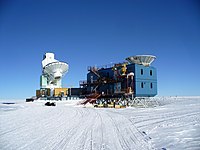
Further to “Gravitational waves flatten? BICEP2 losing its muscle?”, Scientific American tells us, “Backlash to Big Bang Discovery Gathers Steam”:
If the detection of primordial gravity waves weren’t such an enormous deal in the first place, nobody would be making such a fuss. But the BICEP2 results are crucial to verifying inflation, a cornerstone of modern cosmology. The theory was first proposed back in the early 1980s as a solution to a number of cosmological puzzles. One is the fact that the universe appears the same in all directions even though the opposite sides of the visible cosmos could never, under normal circumstances, have been in contact with one another, even at the very beginning. Another is that the universe appears to be flat—two parallel lines won’t touch even if they traverse the entire cosmos. Inflation explained all of these puzzles by positing an episode of superfast expansion long before the cosmos was a billionth of a billionth of a second old.
At first inflation was purely theoretical (although University of California, Santa Cruz, physicist Joel R. Primack said from the beginning that “no theory as beautiful as this has ever been wrong before”).
Oh.
Oh oh.
Oh! Oh! Oh!
It’s important to emphasize that nobody is saying that the telescope or the scientific team are anything less than top-notch, or even that the results are necessarily wrong. But there’s widespread agreement that the results have been overstated. “I just think they got excited and overinterpreted their data,” Spergel says. For his part, Bennett says, “I wouldn’t have held a big press conference about it.” More.
No.
No no.
No no no.
Always get your facts straight before you hold a big press conference. Developing. Follow UD News at Twitter!
See also: The Science Fictions series at your fingertips (cosmology).